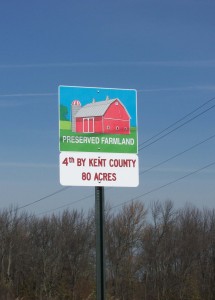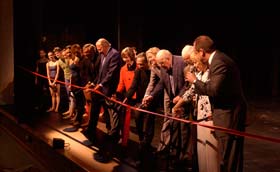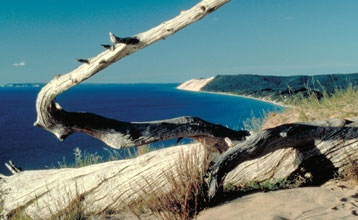In the fall of 2007, United Growth for Kent County gave Peter M. Wege its Land Use Stewardship Award. The environmental land-use organization recognized Wege and the Foundation for supporting farmland preservation, public transit, water quality, green-building initiatives, and energy conservation.
In making the presentation, Paul Haan, President of the United Growth for Kent County Board of Directors, said this: Mr. Wege is being honored today for his commitment to positive land use in Kent County and throughout the state. With Mr. Wege’s leadership, Grand Rapids has the most LEED certified buildings (square footage per capita) of any other city in the country and now the first art museum in the world to be LEED certified.
United Growth was created in 1999 to bring together people and organizations committed to promoting positive land use in the county and West Michigan. Originally a program of the Michigan State University Extension in Kent County, United Growth became its own non-profit in 2007.
To recognize Peter M. Wege’s Stewardship Award, United Growth has placed a brick in the Grand Ideas Garden of the MSU Extension center with his name on it. The purpose of the brick, according to Paul Haan, is “so visitors will be reminded of Mr. Wege’s commitments to our community.”
Through The Wege Foundation, Peter has been a pioneer in preserving Kent County farms by matching funds to buy the Property Development Rights from farmers we want to keep their land a working farm, not a new subdivision. One farm The Wege Foundation helped save is a 74.5 acre parcel in Vergennes Township. By leveraging funds from the USDA Farm and Ranch Lands Protection Program, The Wege Foundation was able to honor the farm owner’s wishes to keep the family farm from development as well as to make the best use of the land.






 In the early 1990s, four women, mothers and grandmothers, realized Grand Rapids, Michigan, needed a place for children to play in creative and hands-on ways. Georgia Woodrick Gietzen, Alyce Greeson, Carla Morris, and Aleicia Woodrick decided to do something about it.
In the early 1990s, four women, mothers and grandmothers, realized Grand Rapids, Michigan, needed a place for children to play in creative and hands-on ways. Georgia Woodrick Gietzen, Alyce Greeson, Carla Morris, and Aleicia Woodrick decided to do something about it.
 Elizabeth Edwards met with members of The Wege Foundation, Ellen Satterlee, Executive Director on the left and Terri McCarthy, VP of Programs on the right, in Grand Rapids, Michigan, on September 22, 2007. This private, non-media event was held at a most appropriate site: Gilda’s House Grand Rapids, a cancer-support home. Created in memory of comedienne Gilda Radner, the 20 Gilda’s Clubs around the country are places where cancer patients and their families gather for support, education, fellowship, and fun.
Elizabeth Edwards met with members of The Wege Foundation, Ellen Satterlee, Executive Director on the left and Terri McCarthy, VP of Programs on the right, in Grand Rapids, Michigan, on September 22, 2007. This private, non-media event was held at a most appropriate site: Gilda’s House Grand Rapids, a cancer-support home. Created in memory of comedienne Gilda Radner, the 20 Gilda’s Clubs around the country are places where cancer patients and their families gather for support, education, fellowship, and fun.
 The September 14, 2007, Grand Rapids Press announced the opening of the Grand Rapids Ballet Company’s new 300-seat Peter Martin Wege Theatre, named for Peter Wege’s father and Steelcase founder. The $6.3 million new theater more than doubled the Grand Rapids Ballet Company’s space bringing it to 40,000 square feet.
The September 14, 2007, Grand Rapids Press announced the opening of the Grand Rapids Ballet Company’s new 300-seat Peter Martin Wege Theatre, named for Peter Wege’s father and Steelcase founder. The $6.3 million new theater more than doubled the Grand Rapids Ballet Company’s space bringing it to 40,000 square feet.
 Wege Foundation Actively Fostering LEED-Certified Projects
Wege Foundation Actively Fostering LEED-Certified Projects
 ECONOMICOLOGY Enters a Global Curriculum at City High
ECONOMICOLOGY Enters a Global Curriculum at City High This mission statement from the IB program could have come right out of Peter’s book ECONOMICOLOGY. The goal of the IB curriculum is to “develop the ability to communicate with and understand people from other countries and cultures.”
This mission statement from the IB program could have come right out of Peter’s book ECONOMICOLOGY. The goal of the IB curriculum is to “develop the ability to communicate with and understand people from other countries and cultures.”